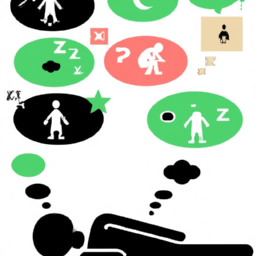Lucid Dreaming Techniques
How To Remember Dreams Clearly

Dreams are captivating and enigmatic occurrences that we all experience on occasion. They can be lively, surreal, or even frightening, yet they never fail to make us ponder their importance and significance. Regrettably, many of us find it challenging to recall our dreams with clarity, which can be disheartening and frustrating.
As a self-proclaimed dream enthusiast, I have discovered several tips and tricks that can help improve dream recall. In this article, I will share my personal experience and provide you with practical advice on how to remember dreams clearly.
First and foremost, it’s important to understand that everyone has different dreaming patterns. Some people have very vivid dreams every night, while others only remember dreams occasionally. Knowing your own dreaming pattern can help you develop a more effective dream recall strategy.
One of the most effective methods is to keep a dream journal, which involves writing down your dreams as soon as you wake up. By doing this, you can train your brain to remember your dreams, and over time, you may notice an improvement in your dream recall.
Key Takeaways
- Keeping a dream journal is one of the most effective methods to improve dream recall.
- Improving sleep habits is crucial for vivid dream recall.
- Practicing visualization exercises can enhance your ability to remember vivid details.
- Using mnemonic devices, such as acronyms and chunking, can help remember dreams better.
Understand Your Dreaming Patterns
You gotta pay attention to your dreaming patterns if you want to remember your dreams clearly. Are you someone who dreams vividly every night or do you only remember your dreams once in a while?
Are your dreams mostly in color or black and white? Do you have recurring dreams or themes that show up in your dreams? Knowing your own dreaming patterns can help you understand how your brain works during sleep and give you clues on how to remember your dreams more effectively.
For example, if you tend to have more colorful dreams, try incorporating more colors into your waking life, such as wearing bright clothing or surrounding yourself with colorful objects. If you often have recurring dreams, pay attention to the details and try to identify any common themes or symbols.
Understanding your own patterns can also help you recognize when you’re dreaming, making it easier to become lucid and take control of your dreams. With this knowledge, you can move on to the next step and create a dream journal.
Create a Dream Journal
Surprisingly, forgetting your dreams is the key to creating a comprehensive dream journal. When you wake up, try to recall any dream fragments or emotions that come to mind, but don’t stress about remembering every detail. Instead, focus on writing down what you do remember in a dream journal.
To make your dream journal effective, consider these tips:
- Keep your journal by your bedside so you can quickly jot down any details upon waking.
- Use descriptive language to capture the mood, setting, and characters in your dream.
- Draw images or symbols that represent your dream if words aren’t enough.
Having a dream journal can help you track your dream patterns and gain insight into your subconscious.
Once you have a solid journal, you can start taking steps to improve your sleep habits for even better dream recall.
Improve Your Sleep Habits
I know that getting enough sleep is crucial for my overall well-being, so I make sure to prioritize my sleep habits.
This means that I aim for 7-8 hours of sleep every night and try to stick to a consistent sleep schedule.
Additionally, I avoid substances that can disrupt my sleep, such as caffeine and alcohol, especially close to bedtime.
Get enough sleep
Ensuring adequate sleep is crucial for vivid dream recall. When we’re sleep-deprived, our brain doesn’t have enough time to go through all the stages of sleep, which include the phase where we dream. This means that we may not remember our dreams as well as we would if we’d gotten enough rest.
Personally, I’ve noticed that when I’m well-rested, I’m more likely to remember my dreams in detail, and they often feel more vivid.
Getting enough sleep can be challenging, especially when we have busy schedules or struggle with insomnia. However, there are several things we can do to improve the quality and quantity of our sleep, such as establishing a bedtime routine and creating a comfortable sleep environment.
By prioritizing our rest, we can improve our dream recall and potentially gain valuable insight from our nighttime experiences.
This is why it’s essential to avoid substances that disrupt sleep, which will be discussed in the next section.
Avoid substances that disrupt sleep
To optimize dream recall, it’s important to steer clear of substances that can interfere with sleep quality. Here are some things I avoid to ensure a restful night’s sleep:
- Caffeine: Drinking coffee or tea, or consuming chocolate or other caffeinated foods or drinks too close to bedtime can make it harder to fall asleep and stay asleep.
- Alcohol: While alcohol can make you feel drowsy initially, it can disrupt your sleep patterns and lead to more fragmented, less restful sleep.
- Nicotine: Smoking or using tobacco products can interfere with sleep quality, making it harder to fall asleep and increasing the likelihood of waking up during the night.
- Certain medications: Some prescription and over-the-counter medications can have side effects that disrupt sleep, so it’s important to talk to your doctor or pharmacist about any concerns you have.
- Heavy meals: Eating a large, heavy meal too close to bedtime can make it harder to fall asleep and may cause discomfort during the night.
By avoiding these substances and habits, I’m able to get a more restful night’s sleep and increase my chances of remembering my dreams in the morning. As I continue to work on improving my dream recall, I’ve also found that practicing visualization exercises can be helpful.
Practice Visualization Exercises
Improve your dream recall by practicing visualization exercises, which have been shown to enhance your ability to remember vivid details. Visualization exercises involve closing your eyes and imagining different scenarios, such as walking through a forest or sitting on a beach. By doing this, you are training your brain to create and store visual memories, which can help you remember your dreams more clearly.
To incorporate visualization exercises into your routine, set aside a few minutes each day to practice. Find a quiet space where you can relax and focus, then close your eyes and imagine yourself in a specific situation. Try to engage as many senses as possible, including sight, sound, touch, and smell. You can also try incorporating elements from your dreams into your visualization exercises to help your brain make connections and strengthen your recall abilities.
By practicing visualization exercises, you can improve your dream recall and remember more of your dreams. As you continue to develop your visualization skills, you may find that you are able to remember even more vivid details and experiences from your dreams. In the next section, we will discuss how to use mnemonic devices to further enhance your dream recall.
Use Mnemonic Devices
I find that using mnemonic devices helps me remember important information. Two methods that work well for me are acronyms and chunking.
Acronyms and abbreviations are helpful for remembering lists of items, while chunking and grouping can help me remember longer pieces of information. For example, I can remember the colors of the rainbow using the acronym ROYGBIV.
I can also chunk a phone number into groups of three or four digits to make it easier to recall.
Acronyms and abbreviations
Don’t let your dream memories fade away, use acronyms and abbreviations to make them unforgettable. A great way to remember your dreams is by creating acronyms and abbreviations for the most important elements. For example, if you dreamt about a red bicycle, you can create an acronym like RB or an abbreviation like RBC to trigger your memory about the dream. Write down your acronyms and abbreviations in a table to make them easily accessible. Here’s an example of a dream and the acronyms that can be used to remember it:
| Dream | Acronyms |
|---|---|
| I was swimming in a pool with dolphins. | SWD, P |
Using acronyms and abbreviations not only helps you remember your dreams better but also saves time when writing them down. Instead of writing out the whole dream, you can simply jot down the acronyms or abbreviations and still be able to recall the dream in detail. Now that you have your acronyms and abbreviations down, let’s move on to the next step of chunking and grouping.
Chunking and grouping is another method to help you remember your dreams with clarity.
Chunking and grouping
By chunking and grouping the key elements of your dream, you can unravel the tangled threads of your subconscious, like a skilled seamstress weaving together a beautiful tapestry.
When you wake up from a dream, try to recall the most vivid and memorable details. Then, group those details into categories and create a mental map of the dream.
Here are some examples of how to chunk and group the key elements of your dream:
- Separate the characters into groups based on their role in the dream (e.g. protagonist, antagonist, supporting character).
- Divide the dream into different scenes or locations.
- Categorize the objects or symbols that appeared in the dream (e.g. animals, objects, colors).
- Group the emotions or feelings that you experienced during the dream.
By chunking and grouping the key elements of your dream, you can make it easier to remember and analyze later on.
As you focus on key details and piece together the puzzle of your subconscious, you’ll unlock a deeper understanding of yourself and your dreams.
Focus on Key Details
Focus on the key details in your dreams to enhance your ability to vividly recall them. As you wake up, try to remember the most salient aspects of your dream, such as the setting, the people involved, and any significant events.
Focusing on these important details as you recall your dream can help you retain more information and improve your ability to recall the dream later on. It’s also helpful to jot down these key details in a dream journal or on your phone as soon as you wake up.
This can help solidify the memory of the dream and make it easier to recall in the future. By focusing on the important details and taking the time to record them, you can significantly enhance your ability to remember your dreams in great detail.
Now, onto the next step: engaging in lucid dreaming.
Engage in Lucid Dreaming
I’ve always been fascinated by the concept of lucid dreaming. In simple terms, it’s the ability to be aware that you’re dreaming while in the dream state. It’s an incredible experience that allows you to take control of your dreams and explore your subconscious mind.
There are various techniques that one can use to induce lucid dreams. I’m excited to discuss them in detail.
What is lucid dreaming?
Lucid dreaming is a thrilling experience that might seem frightening at first, but it can actually be controlled with practice. It’s a state where you become aware that you’re dreaming, while you’re still in the dream.
This means that you can control your dreams, and your dream state becomes a playground for your imagination. You can fly, travel to different worlds, and even meet people who are no longer with you in the waking world.
To achieve lucid dreaming, you need to be able to recognize when you’re dreaming. This can be done by performing reality checks, such as looking at your hands and counting your fingers, or trying to read a piece of writing.
Once you’re able to recognize that you’re in a dream, you can start controlling it. There are various techniques for inducing lucid dreams, and with practice, you can improve your ability to control your dreams.
Techniques for inducing lucid dreams
Have you ever wanted to take control of your dreams and explore a world beyond your waking reality? Well, there are several techniques for inducing lucid dreams that can help you do just that! Lucid dreaming is the state of being aware that you are dreaming while you are still in the dream, which allows you to control and manipulate the dream environment. This can be an incredibly exciting and surreal experience, and it can also be a useful tool for personal growth and self-exploration.
To induce lucid dreams, there are several techniques that you can try. One popular technique is reality testing, which involves regularly asking yourself throughout the day whether you are dreaming or awake. This can help train your brain to recognize when you are in a dream state. Another technique is keeping a dream journal, where you write down your dreams as soon as you wake up. This can help you recognize patterns in your dreams and increase your dream recall. Check out the table below for more techniques to try:
| Technique | Description |
|---|---|
| Wake-Back-to-Bed | Wake up after 5-6 hours of sleep, stay awake for 30-60 minutes, then go back to sleep with intention of lucid dreaming |
| Mnemonic Induction of Lucid Dreams (MILD) | Set an intention to become lucid in your dreams, then repeat a mantra (e.g. "I will realize I’m dreaming") before falling asleep |
| Wake-Initiated Lucid Dreams (WILD) | Stay aware during the transition from wakefulness to sleep, and enter directly into a lucid dream |
| Visualization | Visualize yourself becoming lucid in your dreams before falling asleep |
| Supplements | Certain supplements, such as melatonin or galantamine, may increase the likelihood of lucid dreaming |
By using these techniques, you can increase your chances of experiencing lucid dreams and explore the infinite possibilities of your subconscious mind. And who knows, maybe you’ll even discover something new about yourself in the process. Now, let’s move on to the next section and learn about the benefits of sharing your dreams with others.
Share Your Dreams with Others
Sharing your dreams with others is like planting seeds in a garden, they may grow into something beautiful and unexpected. When we recount our dreams to someone else, we give life to the images and emotions that we experienced while sleeping. This act of sharing can help us remember our dreams more clearly, as well as gain new insights and perspectives on their meaning.
When we hear someone else’s interpretation of our dreams, it can spark new connections and ideas that we may not have considered on our own. However, it’s important to remember that not everyone is equipped to handle the content of our dreams. Some people may dismiss or ridicule our experiences, which can be discouraging.
If this happens, it’s important to seek professional help from a therapist or counselor who is trained to help us explore our dreams in a safe and supportive environment. With their guidance, we can unpack the symbols and themes that emerge in our dreams, and gain a deeper understanding of ourselves.
Seek Professional Help
It’s important to seek professional help if we want to explore the deeper meanings behind our dreams. Sometimes, we may need the guidance and expertise of a therapist or a dream interpreter to help us understand the symbols, emotions, and messages that our dreams are conveying.
These professionals can provide us with insights and perspectives that we may not have considered on our own, and they can also help us identify any patterns or recurring themes in our dreams that we may need to address in our waking life.
However, seeking professional help is not a quick fix or a one-time solution. It requires patience and persistence to work through the layers of our subconscious mind and to unravel the complexities of our dreams.
It may take several sessions or even months to fully comprehend the meaning of a particular dream, and we may need to revisit it from different angles and perspectives. But with practice and dedication, we can develop a deeper awareness of ourselves and our inner world, and we can uncover the hidden treasures that our dreams offer us.
Practice Patience and Persistence
If you’re willing to stick with it, exploring the deeper meanings of your dreams requires a lot of patience and persistence, but the rewards can be well worth the effort.
Remembering your dreams takes time and practice, but with consistent effort, you can train your brain to recall them more vividly.
To start, make a conscious effort to remember your dreams as soon as you wake up in the morning. Keep a dream journal beside your bed and write down any details you can remember, no matter how small or insignificant they may seem.
It’s important to do this as soon as you wake up, as the longer you wait, the more likely you are to forget the details.
With time and practice, you may find that you’re able to remember more and more of your dreams each night.
Frequently Asked Questions
What is the scientific explanation for why we dream?
The scientific explanation for why we dream is not fully understood. However, theories suggest that dreaming helps with memory consolidation, problem-solving, emotional processing, and maintaining brain function.
Can certain foods or drinks affect dream recall?
Certain foods or drinks can affect dream recall. For example, consuming alcohol or caffeine before bed can disrupt sleep and make it harder to remember dreams. Eating a healthy diet and practicing good sleep hygiene can improve dream recollection.
Is it possible to control the content of your dreams?
Controlling the content of my dreams is like trying to steer a ship in a storm. I can influence them by focusing on certain thoughts before sleeping, but ultimately my subconscious takes the wheel.
Are there any negative effects to actively trying to remember your dreams?
Actively trying to remember dreams has no negative effects. However, it may cause frustration if you don’t remember anything. Keeping a dream journal, practicing good sleep hygiene, and setting an intention to remember can be helpful.
Can certain medications or medical conditions affect dream recall?
Certain medications and medical conditions can affect dream recall, such as antidepressants, antihistamines, and sleep apnea. It’s important to talk to a doctor if you’re having trouble remembering your dreams.
Conclusion
Well, I hope these tips have been helpful in guiding you towards remembering your dreams more clearly. It’s not always easy to remember what we dreamt about, but with some patience and persistence, it can be done.
Understanding our own dreaming patterns, keeping a dream journal, and improving our sleep habits are all important steps to take in order to remember our dreams.
Don’t forget to practice visualization exercises and use mnemonic devices to aid in recall. And if you really want to take it to the next level, try engaging in lucid dreaming.
Remember, the more you practice, the better you’ll get. So keep at it, and who knows, maybe one day you’ll be able to remember every single dream you’ve ever had (okay, maybe that’s a bit of a hyperbole, but you get the point).
Sweet dreams!
Eislyn is a gifted writer whose words weave enchanting narratives within the realm of dreams. With a profound love for storytelling and a deep curiosity about dreams, Eislyn’s articles transport readers into vivid dreamscapes.
Her writing style is both eloquent and thought-provoking, captivating readers’ imaginations and inspiring them to dive deeper into the mysteries of their own dreams. Eislyn’s exploration of dream symbolism and interpretation adds depth and nuance to our content, making it an absolute pleasure for dream enthusiasts to engage with.
Lucid Dreaming Techniques
How To Have Dreams At Night

When I lie in bed at night, I often ponder about experiencing vivid and unforgettable dreams. Dreams that transport me on thrilling adventures, assist me in solving issues, or just offer a temporary reprieve from everyday life.
However, for many years, I struggled to have any dreams at all. I would fall asleep, only to wake up the next morning feeling like I had been in a deep slumber with no recollection of any dreams. It wasn’t until I discovered a few simple techniques that I was able to start having dreams on a regular basis.
In this article, I will share with you the tips and tricks that helped me learn how to have dreams at night.
Getting enough sleep is essential for our physical and mental well-being. However, it’s not just the quantity of sleep that matters, but also the quality. Dreams are a natural part of the sleep cycle, and they can provide us with valuable insights and messages from our subconscious mind.
Learning how to have dreams at night can help us tap into this inner wisdom and gain a deeper understanding of ourselves. So, if you’re ready to start exploring the world of dreams, let’s get started!
Key Takeaways
- Getting enough quality sleep is essential for having vivid and memorable dreams, with most dreaming occurring during the Rapid Eye Movement (REM) stage.
- Tips for improving sleep quality include mindfulness, aromatherapy with essential oils, reducing screen time before bed, creating a relaxing environment in the bedroom, and avoiding alcohol and stimulants.
- Techniques for inducing lucid dreaming include reality checks, the Wake back to bed (WBTB) technique, and visualization before bed.
- Keeping a dream journal can help improve dream recall and vividness, providing valuable insights into thoughts and emotions from our subconscious mind. Consistency and persistence are key to achieving more vivid and meaningful dreams.
Importance of Getting Enough Sleep
You gotta make sure you’re getting enough shut-eye if you want your brain to have the energy to conjure up wild and vivid dreams that’ll transport you to another world.
Lack of sleep can result in a reduced ability to dream, and when you do, they tend to be less memorable and meaningful.
Sleep is essential for the brain to process and store new information, which is why it’s crucial to get enough restful sleep if you want to have a chance at dreaming.
When we sleep, our brain goes through several cycles, including the Rapid Eye Movement (REM) stage, which is when most dreaming occurs.
A well-rested brain is more likely to spend more time in the REM stage, which means more opportunities to dream.
So, it’s essential to prioritize getting enough quality sleep to give your brain the chance to dream.
Now, let’s move onto the next section about mindfulness and meditation.
Mindfulness and Meditation
By practicing mindfulness and meditation, you’ll be surprised to know that, according to a study by the National Institutes of Health, 58% of participants reported improved sleep quality.
These practices help calm the mind and reduce stress, which are two common factors that can disrupt sleep. Meditation involves focusing on your breath or a mantra, while mindfulness involves being aware of your thoughts and surroundings without judgment.
Incorporating these practices into your bedtime routine can help you relax and prepare for a restful night’s sleep.
Once you start improving your sleep quality with mindfulness and meditation, you may want to take it a step further by keeping a dream journal.
Writing down your dreams as soon as you wake up can help you remember them better and gain insights into your subconscious mind. It can also be a fun and creative outlet for self-expression.
So give it a try and see where your dreams take you!
Keep a Dream Journal
To enhance your understanding of your subconscious mind, try keeping a dream journal. This is a simple yet effective way to remember your dreams and gain insight into your thoughts and emotions.
Keep a notebook and pen by your bed and write down any details you can remember as soon as you wake up. It’s important to do this immediately as dreams can quickly fade from memory.
Over time, you may notice patterns in your dreams or recurring themes. This can provide valuable information about your innermost desires and fears. By analyzing your dreams, you can gain a better understanding of your subconscious mind and use this knowledge to improve your waking life.
And speaking of improving your dreams, let’s move on to the next topic about setting intentions before bed.
Set Intentions Before Bed
Before hitting the hay, it’s helpful to set intentions for the upcoming night’s rest using positive affirmations. This technique helps to clear your mind and create a peaceful state before you sleep.
Here are three ways to set intentions before bed:
-
Write down positive affirmations in a journal or on a notepad. This could be as simple as writing "I’ll have a peaceful and restful night’s sleep"or "I’ll wake up feeling energized and refreshed."
-
Speak your intentions out loud. This can be done while lying in bed or even while getting ready for bed. Say positive affirmations such as "I’m grateful for the rest I’ll receive tonight"or "I’ll release any stress or tension from my mind and body."
-
Visualize yourself having a restful and peaceful night’s sleep. Imagine yourself in a serene setting, such as a beach or a forest, and visualize yourself feeling calm and relaxed.
Setting intentions before bed can help promote a peaceful and restful night’s sleep. Another helpful technique is to use aromatherapy to create a relaxing atmosphere for sleep.
Use Aromatherapy
Enhance your sleep experience with aromatherapy by using essential oils to create a calming atmosphere in your bedroom. Aromatherapy has been proven to promote relaxation and improve sleep quality. You can use essential oils like lavender, chamomile, or ylang-ylang, which have calming effects on the body and mind.
To use aromatherapy, you can add a few drops of essential oil into a diffuser or a bowl of hot water. Alternatively, you can apply the oil onto your skin or pillowcase. As you inhale the scent, focus on your breathing and allow the calming aroma to soothe your senses.
By incorporating aromatherapy into your nightly routine, you can create a relaxing environment that will help you fall asleep faster and stay asleep longer.
Reducing screen time before bed can also improve your sleep quality. It’s important to avoid bright screens from electronic devices as they can interfere with your body’s natural sleep cycle. Instead, try reading a book or listening to calming music to help you unwind.
Reduce Screen Time Before Bed
Now that we’ve talked about the benefits of using aromatherapy to enhance your dream experience, let’s discuss another important aspect of preparing for a good night’s sleep: reducing screen time before bed. As someone who loves to unwind by scrolling through social media or watching TV, I know how tempting it can be to keep using your phone or computer late into the night. However, studies have shown that the blue light emitted by these devices can disrupt your body’s natural sleep cycle and make it harder to fall asleep. That’s why I’ve started implementing a few simple changes to my bedtime routine to ensure that I’m giving my brain a chance to relax before I try to dream.
One strategy that has worked well for me is setting a specific time each night to put away my devices and start winding down. I’ve found that creating a relaxing environment in my bedroom can also help me prepare for sleep. This might involve dimming the lights, playing some calming music, or taking a warm bath. By making these changes, I’ve noticed that I’m able to fall asleep more quickly and have more vivid dreams throughout the night. Let’s explore this topic further and learn about some techniques for lucid dreaming in the next section.
| Screen Time Tips | Description |
|---|---|
| Set a specific time | Choose a time each night to put away devices and start winding down |
| Create a relaxing environment | Dim the lights, play calming music, or take a warm bath |
| Use a blue light filter | Install an app or use built-in settings to reduce blue light emission |
| Read a book | Choose a physical book to read instead of using a screen before bed |
Transitioning to our next topic, lucid dreaming can be an exciting way to take control of your dream experience and explore your subconscious mind. Let’s dive into some techniques that can help you achieve lucidity in your dreams.
Try Lucid Dreaming Techniques
To achieve lucidity in your dreams, you should try out some techniques that can help you take control of your dream experience and explore your subconscious mind. But have you ever wondered what it would be like to have complete control over your dreams? That’s where lucid dreaming comes in – it’s the ability to be aware that you are dreaming and take control of the dream narrative.
Here are a few techniques you can try to induce lucid dreaming:
-
Reality checks: During the day, ask yourself if you’re dreaming and perform simple reality checks like trying to push your finger through your palm. This habit will carry over to your dreams and help you recognize when you are dreaming.
-
Wake back to bed (WBTB): Set an alarm for 4-6 hours after you go to sleep, wake up and stay up for 30-60 minutes before going back to sleep. This can increase your chances of having a lucid dream during the second half of your sleep cycle.
-
Visualization: Before going to bed, visualize yourself becoming aware that you’re dreaming and taking control of your dream. This can help set the intention in your mind to have a lucid dream.
Now that you know how to induce lucid dreaming, it’s time to create a relaxing sleep environment for optimal dreaming.
Create a Relaxing Sleep Environment
Transform your bedroom into a peaceful sanctuary where you can unwind and drift into a deep, restful sleep. Start by decluttering and minimizing any distractions in your bedroom. Keep electronics out of the bedroom, or at least out of reach, as the blue light emitted from screens can disrupt your sleep cycle.
Replace bright overhead lights with dimmer, warmer lighting to create a calming ambiance. If outside noise is an issue, invest in a white noise machine or earplugs to block out any disturbances. Invest in comfortable bedding and pillows that promote relaxation. Consider using essential oils, such as lavender, which can help calm the mind and body.
Keep your bedroom at a cool temperature and ensure proper ventilation to promote a comfortable sleeping environment. By creating a peaceful sleep environment, you can increase the likelihood of having restful, uninterrupted sleep – which can, in turn, lead to more vivid dreams.
Avoid alcohol and stimulants before bed, as these can disrupt your sleep cycle and reduce the quality of your sleep.
In the next section, we’ll explore other techniques to help you have dreams at night.
Avoid Alcohol and Stimulants
You’ll feel more refreshed and alert in the morning if you steer clear of alcohol and stimulants before bedtime. While alcohol may initially make you feel drowsy, it actually disrupts the quality of your sleep, causing you to wake up frequently throughout the night.
Similarly, stimulants like caffeine and nicotine can keep you awake and make it difficult to fall asleep. It’s best to avoid these substances for at least a few hours before bedtime to give your body a chance to wind down and prepare for sleep.
Remember, developing a consistent sleep routine takes patience and persistence. It may take some time for your body to adjust to new habits, so don’t get discouraged if you don’t see immediate results. Keep practicing good sleep hygiene, including avoiding alcohol and stimulants before bed, and eventually your body will start to associate these behaviors with sleep and relaxation.
In the next section, we’ll discuss the importance of setting a regular sleep schedule to further improve your chances of having restful, dream-filled nights.
Patience and Persistence
I’ve learned that having vivid dreams at night takes patience and persistence. Consistency is key when it comes to training your brain to have more vivid dreams.
It’s important to remember that it takes time for your brain to adjust and for you to start experiencing the benefits of dream work.
The Importance of Consistency
To achieve consistent dreaming, it’s essential that I establish a regular sleep schedule. Do I ever wake up feeling groggy and disoriented because I went to bed at different times every night? Absolutely!
Our bodies are creatures of habit, and when we don’t stick to a routine, it can disrupt our natural sleep cycles. When we establish a consistent sleep schedule, we signal to our brains that it’s time to wind down and prepare for sleep. This can lead to more restful and deeper sleep, which can increase the chances of having vivid dreams.
Consistency is key when it comes to dreaming. It takes time to train my brain to dream more vividly, and it won’t happen overnight. However, if I stick to a regular sleep schedule and maintain healthy sleep habits, I can improve my chances of having more vivid and memorable dreams.
So, if I want to experience more exciting and imaginative dreams, I need to commit to a consistent sleep routine and give my brain the time it needs to adjust.
It Takes Time to Train Your Brain to Dream More Vividly
Training your brain to dream more vividly is a process that requires patience and consistency. It may take some time for your mind to adjust to the new habits and patterns you are trying to establish. But with perseverance, you can increase the frequency and intensity of your dream experiences.
One effective technique for improving dream recall and vividness is keeping a dream journal. This involves writing down your dreams immediately after waking up, while the details are still fresh in your mind. This helps you to become more aware of your dreams and to recognize patterns or recurring themes. You can also use the table below to track your progress and identify any changes in your dream content or quality over time. Remember to be patient with yourself and enjoy the journey towards a more fulfilling dream life.
| Date | Dream Description | Vividness Rating |
|---|---|---|
| 1/1/22 | Flying over mountains | 7/10 |
| 1/5/22 | Talking to an old friend | 5/10 |
| 1/10/22 | Being chased by a monster | 9/10 |
| 1/15/22 | Swimming in the ocean | 8/10 |
Frequently Asked Questions
Can certain foods affect the frequency or quality of dreams?
I’ve noticed that certain foods can affect the frequency and quality of my dreams. For instance, eating spicy or heavy meals before bed often leads to vivid and intense dreams. Conversely, a light and balanced meal can result in more peaceful and restful sleep.
Is it possible to have too many dreams at night?
Yes, it is possible to have too many dreams at night. Sometimes, I wake up feeling exhausted because my mind was busy all night. It’s important to find a balance and allow for restful sleep.
Can stress or anxiety affect the ability to have dreams?
Stress and anxiety can significantly affect my ability to have dreams at night. By constantly worrying, my brain is too preoccupied to enter the dream state. Relaxation techniques before bed can help alleviate these concerns and promote more restful sleep.
Are there any specific sleep positions that can enhance dreaming?
I’m not aware of any specific sleep positions that can enhance dreaming. However, maintaining a comfortable position that allows for uninterrupted sleep can improve the quality of sleep, which may lead to more vivid dreams.
Can certain medications interfere with dream recall or lucid dreaming techniques?
Certain medications, such as antidepressants and sleep aids, can interfere with dream recall and lucid dreaming techniques. It’s important to speak with a healthcare provider if you’re experiencing difficulty with dream recall while taking medication.
Conclusion
Well folks, that’s all for now on how to have dreams at night. It’s been quite the journey, hasn’t it?
We’ve covered everything from the importance of getting enough sleep to lucid dreaming techniques. But as with any journey, the destination is not the only important thing.
In the end, it’s the journey itself that matters most. The journey of exploring the depths of our minds and unlocking the potential of our dreams.
So let’s continue down this path, with patience and persistence, and see where it takes us. Who knows? Perhaps we’ll find ourselves in a world where anything is possible, where the only limit is our own imagination.
And that, my friends, is a journey worth taking.
Eislyn is a gifted writer whose words weave enchanting narratives within the realm of dreams. With a profound love for storytelling and a deep curiosity about dreams, Eislyn’s articles transport readers into vivid dreamscapes.
Her writing style is both eloquent and thought-provoking, captivating readers’ imaginations and inspiring them to dive deeper into the mysteries of their own dreams. Eislyn’s exploration of dream symbolism and interpretation adds depth and nuance to our content, making it an absolute pleasure for dream enthusiasts to engage with.
Lucid Dreaming Techniques
Dreams That Continue Where They Left Off

I have always been intrigued by dreams. When I was young, I experienced vivid, recurring dreams that left me feeling both puzzled and fascinated. As I got older, my curiosity grew about the science of dreaming and the different methods to control our dreams.
One phenomenon that has always caught my attention is the idea of dreams that continue where they left off. Have you ever experienced a dream where you woke up in the middle of it, only to fall back asleep and continue exactly where you left off? It’s a strange and surreal experience, and one that has puzzled scientists and dream enthusiasts alike.
In this article, we will explore the concept of dreams that continue where they left off, the science behind dreaming, and the various theories on why dreams continue. We will also delve into personal experiences with these types of dreams, techniques for inducing lucid dreams, and the benefits and challenges of lucid dreaming.
Key Takeaways
- Dreams that continue where they left off can be very detailed and realistic, and may be a sign that the subconscious mind is trying to work through something important.
- The continuity theory, activation-synthesis theory, evolutionary theory, and emotional regulation theory are all theories on why dreams continue where they left off.
- Personal experiences with dreams that continue vary, but they often occur when the dreamer has a lot on their mind.
- Reality testing and checking can help distinguish between waking life and dreaming.
Understanding Lucid Dreams
So, you wanna understand lucid dreams and take control of your subconscious mind? Well, let me tell ya, it’s not as difficult as ya may think.
Lucid dreams are dreams in which ya are aware that ya are dreaming and can control the dream’s content. This level of consciousness allows ya to explore yer mind and even overcome fears or anxieties.
To achieve lucid dreams, the first step is to improve yer dream recall. Keep a dream journal next to yer bed and write down yer dreams as soon as ya wake up. This practice will help ya remember yer dreams more vividly and recognize patterns.
Another technique is to do reality checks throughout the day, asking yerself if ya are dreaming. This habit will eventually carry over to yer dreams, and ya will realize when ya are dreaming. With practice, ya can learn to manipulate yer dreams and even turn nightmares into positive experiences.
Now, let’s move on to the next topic: what are dreams that continue where they left off?
What are Dreams That Continue Where They Left Off?
You may have experienced a type of dream that picks up right where it ended the night before, almost as if you never woke up at all. These are called dreams that continue where they left off, and they can be quite vivid and intense.
Here are three things to keep in mind about this type of dream:
-
Dreams that continue where they left off are often very detailed and realistic. You may find yourself in the same place you were in the previous dream, with the same people and events occurring.
-
These dreams may be a sign that your subconscious mind is trying to work through something important. If you find that you keep having dreams that continue where they left off, it may be worth exploring what your mind is trying to tell you.
-
While dreams that continue where they left off can be fascinating, they can also be exhausting. Your mind may feel like it hasn’t had a break from the dream world, and you may wake up feeling tired and drained.
Dreams that continue where they left off are just one of the many fascinating aspects of dreaming. In the next section, we’ll explore the science behind dreaming and what we know about why we dream.
The Science Behind Dreaming
Get ready to grasp the great and glorious guide to the gripping and ground-breaking science behind the mysterious world of dreaming. As humans, we spend approximately one-third of our lives sleeping, and during this time, our brains enter a state of unconsciousness where we experience a range of emotions, sensations, and perceptions that we call dreams. While the exact science behind dreaming remains a mystery, research has shown that dreams are a result of the brain’s natural and essential process of consolidating memories, processing emotions, and regulating mood.
To understand the science behind dreaming, it is important to recognize the different stages of sleep. Sleep is divided into two main stages: rapid eye movement (REM) and non-rapid eye movement (NREM). During REM sleep, our brains are highly active, and this is when we experience most of our vivid and memorable dreams. In contrast, NREM sleep is characterized by deep, restorative sleep where our brains are less active, and we are less likely to remember our dreams. A 3 column and 3 row table in markdown format can help visualize the different stages of sleep:
| Sleep Stage | Brain Activity | Dream Experience |
|---|---|---|
| Rapid Eye Movement | Highly Active | Vivid and Memorable |
| Non-REM Sleep | Less Active | Less Memorable |
| Awake | Highly Active | None |
Theories on why dreams continue will be explored in the subsequent section, shedding light on the reasons why dreams can seem to pick up where they left off.
Theories on Why Dreams Continue
Now let’s delve into why our brains persist in creating these vivid and memorable experiences during REM sleep. There are several theories on why dreams continue where they left off, and here are some of them:
-
The continuity theory suggests that dreams continue because our brains are trying to create a coherent narrative that makes sense to us.
-
The activation-synthesis theory proposes that dreams are simply random electrical signals that our brains try to make sense of by creating a story.
-
The evolutionary theory suggests that dreams continue because they serve an important biological purpose, such as helping us process and remember important information.
-
The emotional regulation theory proposes that dreams continue because they allow us to work through unresolved emotional issues in a safe and controlled environment.
All of these theories offer different explanations for why our brains persist in creating dreams that pick up where they left off. However, regardless of the theory, it’s clear that our dreams serve an important function in our lives.
Now, let’s explore some personal experiences with dreams that continue.
Personal Experiences with Dreams That Continue
Sometimes, when you’re caught up in a dream that seems to last forever, it feels like you’re living in an alternate reality where time operates differently. I’ve had several experiences where my dreams continue from where they left off, as if they were a TV series with a cliffhanger ending. It’s always a strange sensation to wake up from such a dream, only to realize that it wasn’t real.
In my personal experience, these dreams often occur when I have a lot on my mind and my brain is trying to work through a problem or situation. It’s almost as if my subconscious is trying to provide me with a solution or resolution to whatever is bothering me. However, I’ve also had dreams that continue simply because they were enjoyable or entertaining, and my mind wanted to continue the story. It’s fascinating to think about how my brain is capable of creating such complex and vivid storylines, even while I’m asleep.
Transitioning into the next section, one technique I’ve tried to induce lucid dreams is reality testing.
Techniques for Inducing Lucid Dreams
I’ve been interested in lucid dreaming for a while now, and I’ve tried a few different techniques to induce them.
One technique that’s been particularly helpful for me is reality testing and reality checking.
Another technique that I’ve found useful is wake-induced lucid dreaming. This involves waking up in the middle of the night and then going back to sleep with the intention of having a lucid dream.
Finally, I’ve also found that keeping a dream journal is incredibly important for increasing the frequency of lucid dreams.
Reality Testing and Reality Checking
Feeling unsure about whether you’re awake or still dreaming? Reality testing and checking can help you distinguish between the two.
These techniques involve questioning your environment and physical sensations to determine if they follow the rules of reality. For example, you might try pushing your finger through your palm or reading a sentence twice to see if it changes.
By consistently performing these reality checks throughout the day, you may be more likely to notice oddities in your dreams and become lucid.
Reality testing and checking can be especially helpful for inducing wake-induced and mnemonic-induced lucid dreams.
In wake-induced lucid dreams, you consciously enter a lucid dream state from a waking state. By frequently questioning your reality during the day, you may increase your chances of realizing you’re dreaming while still conscious.
Mnemonic-induced lucid dreams, on the other hand, involve setting an intention to have a lucid dream before falling asleep. By incorporating reality testing and checking into your pre-sleep routine, you may be more likely to recognize when you’re dreaming and achieve lucidity.
Wake-Induced and Mnemonic-Induced Lucid Dreams
By combining reality testing and intentional dreaming, I’ve increased my chances of experiencing a lucid dream state. This has allowed me to have more control over my dreams and even continue them where they left off.
There are two types of lucid dreams that have been particularly helpful for me: wake-induced lucid dreams and mnemonic-induced lucid dreams.
Wake-induced lucid dreams occur when I wake up in the middle of the night and go back to sleep with the intention of having a lucid dream. This technique involves setting an alarm to wake up after a few hours of sleep, staying awake for a short period of time, and then going back to sleep with the intention of having a lucid dream.
Mnemonic-induced lucid dreams, on the other hand, involve using specific cues or triggers to help me recognize that I am dreaming. This could include using a mantra such as "I’m dreaming"before going to sleep or setting an intention to recognize a specific dream sign.
By utilizing these techniques, I’ve been able to continue my dreams where they left off and even control the outcome of my dreams.
Dream journaling is another important aspect of intentional dreaming. By recording my dreams immediately upon waking up, I’ve been able to better understand my dream patterns and identify recurring themes or symbols. This has helped me become more aware of my subconscious thoughts and emotions, which has in turn allowed me to have more control over my dreams.
By incorporating reality testing and intentional dreaming, dream journaling, and reality checking into my sleep routine, I’ve been able to achieve a greater level of awareness and control over my dreams.
The Importance of Dream Journaling
To enhance your awareness and control over your dream state, it’s important to regularly record your dreams in a journal immediately upon waking up. This practice of dream journaling allows you to remember your dreams more vividly and in greater detail.
By documenting your dreams, you can identify recurring themes, symbols, and patterns that may hold personal significance and offer insights into your inner psyche.
Furthermore, dream journaling can help you become more attuned to your dream signs, which are cues that indicate you are dreaming. By recognizing these signs, you can enter into a lucid dream state where you have greater control over your actions and the dream environment.
This leads us into the next section about the benefits of lucid dreaming, where we explore the potential for personal growth and self-discovery through this unique state of consciousness.
The Benefits of Lucid Dreaming
Lucid dreaming can enhance problem-solving skills and increase creativity. When I become aware that I’m dreaming, I can take control and manipulate the dream world around me.
This allows me to explore new possibilities and experiment with different scenarios that I may not have thought of in my waking life. Through lucid dreaming, I’ve been able to overcome fears and anxieties by facing them head-on in a safe and controlled environment.
I’ve also gained a deeper understanding of myself and my subconscious mind, which has helped me to better navigate my waking life. Additionally, lucid dreaming has provided me with a sense of empowerment and excitement, as I’m able to experience things that would otherwise be impossible in the real world.
However, with these benefits come risks and challenges that must be taken into consideration.
The Risks and Challenges of Lucid Dreaming
I’ve been practicing lucid dreaming for some time now, and while there are many benefits to this practice, there are also some risks and challenges to be aware of.
One of the biggest challenges I’ve faced is sleep disturbances and insomnia. The excitement of lucid dreaming can sometimes make it difficult to fall asleep in the first place.
I’ve also experienced false awakenings and sleep paralysis, which can be quite frightening and disorienting.
Additionally, there’s always the risk of losing touch with reality if you become too obsessed with lucid dreaming and start to confuse your dreams with real life.
Sleep Disturbances and Insomnia
If you’re having trouble falling asleep or staying asleep, your dreams may feel like a never-ending movie that keeps playing on a loop, leaving you feeling exhausted and drained.
Sleep disturbances and insomnia can lead to a variety of negative effects, including difficulty concentrating, daytime fatigue, and irritability. These sleep issues can also cause your dreams to feel disjointed and confusing, making it difficult to remember or understand them.
Insomnia can also lead to a phenomenon known as false awakening, where you believe you’ve woken up but are still actually dreaming. This can be a disorienting and frustrating experience, as it can be difficult to differentiate between reality and the dream world.
False awakenings can also lead to sleep paralysis, where you’re unable to move or speak while in a dream state. This can be a terrifying experience, as it often feels like you’re unable to escape from a nightmare.
False Awakening and Sleep Paralysis
Get ready for a terrifying experience – false awakenings and sleep paralysis can leave you feeling trapped in a nightmare. False awakening is a phenomenon where you wake up in your dream and believe that you are awake, but in reality, you are still asleep. This can lead to confusion and panic as you try to perform your usual morning routine, only to realize that it was all in your head.
Sleep paralysis, on the other hand, is a state where you are fully aware of your surroundings but cannot move or speak. It can be accompanied by hallucinations, making it even more scary and confusing. In order to understand the difference between these two phenomena, I have created a table below that highlights the key characteristics of each. Despite the fear they may induce, false awakenings and sleep paralysis are common experiences, and understanding them can help alleviate some of the anxiety they may cause.
| False Awakening | Sleep Paralysis |
|---|---|
| You believe you are awake, but you are still asleep | You are fully aware of your surroundings, but cannot move or speak |
| Can be accompanied by a feeling of confusion and panic | Can be accompanied by hallucinations |
| Typically occurs during REM sleep | Can occur during any stage of sleep |
Now that we have a better understanding of false awakenings and sleep paralysis, it’s important to note that these experiences can sometimes lead to losing touch with reality. Let’s explore this further in the next section.
Losing Touch with Reality
As I delve deeper into the world of sleep-related phenomena, I may encounter the unsettling experience of losing touch with reality. It feels like I’m wandering through a dark forest without a map or compass, where nothing seems familiar and everything is surreal.
It’s a feeling of being trapped in a dream that’s so vivid it becomes hard to differentiate between reality and imagination. This experience of losing touch with reality is often associated with lucid dreaming, where the dreamer becomes aware that they’re dreaming but may struggle to control the dream.
Understanding this phenomenon and exploring its causes can lead to a better understanding of the human mind and its connection to the unconscious. As we continue to unravel the mysteries of the sleeping mind, we may find ways to harness the power of dreams for personal growth and self-discovery.
Future Directions in Dream Research
In this section, I’ll discuss the future directions of dream research. I believe that advancements in neuroscience and technology will continue to provide new insights into the workings of the brain during sleep.
Additionally, cross-cultural and historical perspectives, as well as interdisciplinary approaches to dream studies, will be crucial in understanding the universal and individual aspects of dreaming.
Advancements in Neuroscience and Technology
With advancements in neuroscience and technology, I find it fascinating that researchers are now able to explore the brain activity during sleep and understand why some people have dreams that continue where they left off.
Here are four fascinating things that researchers have discovered:
- Brain activity during sleep is different from wakefulness, with certain areas of the brain becoming more active during different stages of sleep.
- The brain is constantly processing information during sleep, even if we’re not aware of it.
- Dreams can be influenced by external factors, such as sounds or smells in the environment.
- Some people have more vivid and memorable dreams than others, and this may be linked to differences in brain activity during sleep.
As we learn more about the brain and sleep, it’s important to also consider cross-cultural and historical perspectives on dreaming.
Cross-Cultural and Historical Perspectives
Wow, delving into the cross-cultural and historical perspectives of dreaming is like opening a treasure trove of knowledge.
In many cultures, dreams aren’t seen as just random mental activity, but as a way to connect with the divine or spiritual world. For example, in traditional Chinese culture, dreams were believed to be messages from ancestors or deities, and were often used for divination and guidance.
Similarly, many Native American tribes believed that dreams were a way to communicate with ancestors and spirits, and that they held important messages and warnings.
Furthermore, throughout history, dreams have played a significant role in shaping literature, art, and even political movements. From ancient Greek mythology to Shakespeare’s plays, dreams have been used as a tool to convey deeper meanings and themes.
Even in modern times, dreams continue to inspire and influence creative works. Understanding the cultural and historical significance of dreams can provide valuable insights into the human experience and how we perceive the world around us.
With this understanding, we can approach dream studies from a more holistic perspective and gain a deeper appreciation for the role that dreams play in our lives.
This leads us to the next section on interdisciplinary approaches to dream studies.
Interdisciplinary Approaches to Dream Studies
Exploring the diverse ways in which dream studies intersect with fields such as psychology, neuroscience, and anthropology can reveal new insights into the nature of the dreaming mind. As a researcher, I’ve found that studying dreams from an interdisciplinary perspective allows for a richer understanding of the complexities of human cognition and experience.
Here are four examples of how interdisciplinary approaches can enhance dream studies:
-
Combining neuroscientific methods, such as EEG and fMRI, with subjective dream reports can provide a more comprehensive understanding of the neural processes underlying dreaming.
-
Examining cross-cultural variations in dream content and interpretation can illuminate the influence of cultural factors on the construction of meaning in dreams.
-
Integrating psychoanalytic theory with empirical research can shed light on the unconscious processes that shape dream content and the role of dreams in psychological development.
-
Using anthropological methods, such as participant observation and ethnography, to study dream practices in different societies can reveal the social and cultural functions of dreaming.
By drawing on diverse fields of inquiry, we can gain a more nuanced understanding of the dreaming mind and its role in human experience.
Frequently Asked Questions
How do I know if I’m having a dream that continues where it left off?
On average, people have 4-6 dreams per night. To determine if a dream continues where it left off, I focus on details from the previous dream and see if they carry over.
Can lucid dreaming be dangerous?
Lucid dreaming can be dangerous if not practiced responsibly. It can lead to sleep deprivation, false memories, and even sleep paralysis. It’s important to research and understand the risks before attempting lucid dreaming.
Is there a way to control the content of dreams that continue where they left off?
There are several techniques to control dream content, such as reality testing, visualization, and setting intentions before sleep. However, the specific issue of dreams continuing where they left off may require more personalized strategies.
Are there any medications or supplements that can enhance lucid dreaming?
I’ve heard that there are certain supplements, like galantamine and choline, that can enhance lucid dreaming. However, it’s important to consult with a doctor before taking any new medication or supplement.
Can dreams that continue where they left off be a sign of a psychological disorder?
My mind is a never-ending puzzle, but I know dreams aren’t necessarily a sign of a psychological disorder. Continuation dreams may just be a normal part of our subconscious processing.
Conclusion
So, there you have it – dreams that continue where they left off are a fascinating phenomenon that has puzzled scientists and dream enthusiasts alike. While we may not have all the answers yet, the science behind dreaming and lucid dreaming has shed some light on this intriguing topic.
As someone who’s experienced dreams that continue, I find it both exciting and a bit unsettling at times. However, with the right techniques, we can learn to control our dreams and explore the benefits of lucid dreaming.
One statistic to consider is that approximately 55% of people have experienced at least one lucid dream in their lifetime. This highlights the fact that lucid dreaming is not uncommon and is a natural part of the human experience.
With more research and understanding, we may be able to unlock the full potential of our dreams and use them to enhance our waking lives. So, whether you’re a skeptic or a believer, it’s worth exploring the world of lucid dreaming and seeing where your dreams can take you.
Eislyn is a gifted writer whose words weave enchanting narratives within the realm of dreams. With a profound love for storytelling and a deep curiosity about dreams, Eislyn’s articles transport readers into vivid dreamscapes.
Her writing style is both eloquent and thought-provoking, captivating readers’ imaginations and inspiring them to dive deeper into the mysteries of their own dreams. Eislyn’s exploration of dream symbolism and interpretation adds depth and nuance to our content, making it an absolute pleasure for dream enthusiasts to engage with.
Lucid Dreaming Techniques
How To Have More Dreams

Yes, I have definitely experienced the feeling of missing out on an adventure because I couldn’t recall my dreams.
Dreams are like a secret world, a place where we can explore our deepest desires and fears without any consequences. But what if I told you that there are ways to have more dreams and even control them? It’s like having a VIP pass to your own private amusement park.
Let’s dive into the science of dreams and discover how you can have more of them.
Dreams are like the ocean, vast and mysterious, yet full of treasures waiting to be discovered. However, sometimes the waves are too rough, and we can’t see what lies beneath. That’s where the tips and tricks in this article come in handy.
By understanding the science of dreams and implementing certain practices in your daily routine, you can increase the frequency, vividness, and control of your dreams.
So, put on your snorkeling gear, and let’s dive into the world of dreams.
Key Takeaways
- Keeping a dream journal can improve dream recall and identify recurring themes.
- Practicing relaxation techniques and managing stress can increase the chances of having vivid dreams.
- Experimenting with sleep positions and investing in comfortable bedding can stimulate the brain and increase dream frequency.
- Using lavender essential oil through aromatherapy can promote deeper, more restful sleep and enhance dream experiences.
Understand the Science of Dreams
You wanna know why you dream and how understanding the science behind it can help you have more vivid dreams? Let’s dive in!
Dreams occur during the REM (Rapid Eye Movement) phase of sleep, which happens about 90 minutes after you fall asleep and reoccurs every 90 minutes thereafter. During this phase, your brain is highly active, and your body is in a state of paralysis. This paralysis is a safety mechanism to prevent you from acting out your dreams physically.
Scientists believe that our dreams serve many purposes, such as consolidating memories, processing emotions, and problem-solving. By understanding the science behind dreams, you can learn how to optimize your sleep and have more vivid dreams.
So, let’s move on to the next step and learn how keeping a dream journal can help you remember more of your dreams.
Keep a Dream Journal
I personally find keeping a dream journal to be incredibly helpful in understanding my dreams. The benefits of journaling include improving dream recall, identifying recurring themes and symbols, and creating a space for self-reflection.
When recording your dreams, it’s important to include as much detail as possible, including emotions and physical sensations. By analyzing your dreams, you can gain insight into your subconscious thoughts and feelings.
The Benefits of Journaling
By regularly journaling your dreams, you can gain insight into your subconscious mind and potentially improve your overall well-being. Writing down your dreams as soon as you wake up can help you remember more details and make connections between your dreams and your waking life.
Additionally, keeping a dream journal can help you identify recurring themes or patterns in your dreams, which can provide valuable information about your thoughts and feelings.
The benefits of journaling extend beyond simply remembering your dreams. Writing down your thoughts and emotions can help you process and make sense of them, leading to a greater understanding of yourself. It can also serve as a way to reduce stress and anxiety by releasing pent-up emotions and promoting a sense of mindfulness.
With these benefits in mind, it’s clear that keeping a dream journal can not only help you have more vivid dreams, but also improve your mental and emotional well-being. So, how can you start recording your dreams?
How to Record Your Dreams
Like a detective collecting clues, I always make sure to jot down any details I remember about my dreams as soon as I wake up. This helps me to record my subconscious thoughts and keep track of any recurring themes or symbols.
Here are three tips for recording your dreams:
- Keep a journal or notepad by your bed – this will make it easy to write down any details you remember as soon as you wake up.
- Write in the present tense – this’ll help you to remember the dream more vividly.
- Don’t worry about writing in complete sentences or making sense – just jot down any details that come to mind.
By recording your dreams regularly, you’ll start to notice patterns and recurring themes. This can be helpful when it comes to analyzing your dreams and gaining insight into your subconscious mind.
Analyzing Your Dreams
To truly understand the meanings behind your dreams, you must dive deeper into the symbols and themes that appear and reflect on how they may relate to your waking life. One way to do this is by analyzing your dreams.
Take note of the prominent themes and symbols that appear in your dreams. Reflect on how they make you feel and what memories or experiences they bring up for you. You can use a dream journal to record these observations and patterns.
Analyzing your dreams can help you gain insight into your subconscious mind and your emotions. It can also help you identify patterns and themes that may be present in your waking life.
Once you have a better understanding of your dreams, you can use this knowledge to practice lucid dreaming. With lucid dreaming, you can take control of your dreams and explore your subconscious mind in a more intentional way.
Practice Lucid Dreaming
Want to experience the thrilling adventure of controlling your dreams? Start practicing lucid dreaming! Lucid dreaming is a technique that allows you to become aware that you are dreaming while you’re still asleep. This means that you can control your dreams and make them as exciting and adventurous as you want them to be.
To start practicing lucid dreaming, there are a few things you can do. One is to keep a dream journal and write down your dreams as soon as you wake up. This will help you become more aware of your dreams and will increase your chances of realizing that you’re dreaming.
Another technique is to do reality checks throughout the day, such as looking at your hands or a clock and asking yourself if you’re dreaming. With practice, these habits will become second nature and you’ll be on your way to having more lucid dreams.
Now, let’s move on to improving your sleep habits.
Improve Your Sleep Habits
Improve your sleep habits by setting a regular bedtime and wake-up time. Remember the old adage, ‘early to bed, early to rise, makes a man healthy, wealthy, and wise.’
Here are some tips to help you improve your sleep habits and increase your chances of having more dreams:
- Avoid caffeine and alcohol before bedtime
- Keep your bedroom cool and dark
- Avoid using electronic devices at least an hour before bed
- Practice relaxation techniques before bed, such as meditation or deep breathing exercises
- Invest in a comfortable mattress and pillows
By following these tips, you can improve the quality of your sleep and increase the likelihood of having more dreams.
In the next section, we’ll discuss how certain foods and supplements can also enhance your dream experiences.
Use Dream-Enhancing Foods and Supplements
I’ve been working on improving my sleep habits, and it’s been helping me have more vivid dreams. But I wanted to take it a step further and try some dream-enhancing foods and supplements.
I did some research and found that certain foods and supplements can enhance your dreams, making them more vivid and memorable. One food that is said to enhance dreams is cheese. Specifically, cheddar cheese has been shown to increase the production of a neurotransmitter called acetylcholine, which is important for REM sleep and dreaming.
Additionally, there are supplements like vitamin B6 and melatonin that can aid in dream recall and promote more vivid dreams. I’m excited to try incorporating some of these foods and supplements into my diet and see if it makes a difference in my dream experiences.
Speaking of dream experiences, another technique for having more vivid dreams is visualization.
Try Visualization Techniques
You can enhance your dream experiences by incorporating visualization techniques into your routine, allowing you to fully immerse yourself in your dream world. Visualization involves creating detailed mental images of the dream you want to have, and focusing your thoughts on specific details or scenarios.
Here are some visualization techniques that have worked for me:
-
Create a dream scenario: Visualize a specific dream scenario that you want to experience, such as flying over a beautiful landscape or meeting a celebrity. Imagine the details of the scene, including the colors, sounds, and textures.
-
Use affirmations: Repeat positive affirmations to yourself, such as "I’ll have a vivid dream tonight"or "I’ll remember my dreams in the morning."This helps to set a positive intention for your dream experience.
By incorporating visualization techniques into your routine, you can increase your chances of having more vivid and memorable dreams. In addition to visualization, another way to enhance your dream experiences is to incorporate aromatherapy.
Incorporate Aromatherapy
I love using aromatherapy to help me have more vivid and meaningful dreams. One of the best ways to do this is by using essential oils for sleep and dreams.
There are a variety of ways to use aromatherapy for dreaming, but it’s important to take precautions and use these oils safely.
Essential Oils for Sleep and Dreams
Relax and let the soothing scent of lavender essential oil transport you to a peaceful night’s sleep filled with vivid and meaningful dreams. Lavender has been used for centuries as a natural remedy for sleep disorders and anxiety. It’s known for its calming and relaxing properties that promote deeper and more restful sleep.
In addition, lavender essential oil can enhance dream recall and promote lucid dreaming, allowing you to explore your subconscious mind and unlock hidden insights and creativity.
To use aromatherapy for dreaming, you can diffuse lavender essential oil in your bedroom before bedtime, add a few drops to a warm bath, or apply it topically to your pulse points. You can also mix lavender with other essential oils such as chamomile, ylang-ylang, or bergamot to create a customized blend that suits your needs and preferences.
Experiment with different oils and techniques to find what works best for you and enjoy a restful and rejuvenating night’s sleep filled with inspiring dreams.
How to Use Aromatherapy for Dreaming
Transform your nighttime routine with the power of aromatherapy and experience the wonders of lucid dreaming and enhanced dream recall using essential oils like lavender, chamomile, ylang-ylang, and bergamot.
To use aromatherapy for dreaming, you can add a few drops of essential oil to a diffuser or a cotton ball and place it next to your pillow. As you inhale the soothing scent, focus on your intention to have a vivid dream or a lucid dream.
You can also apply diluted essential oils to your temples, neck, or wrists before sleep to promote relaxation and stimulate dream activity.
However, it’s important to take precautions and ensure safety when using essential oils for aromatherapy. Always use high-quality, pure essential oils and avoid using too much oil.
Some essential oils may cause skin irritation or allergic reactions, so it’s recommended to do a patch test before using them on your skin. Additionally, if you’re pregnant, nursing, or have any medical conditions, consult with a healthcare professional before using essential oils.
With these precautions in mind, you can enjoy the benefits of aromatherapy for dreaming and enhance your dream experience.
Precautions and Safety
I hope you found the previous subtopic about using aromatherapy for dreaming helpful. Before you start using essential oils for your dreams, it’s important to take precautions and consider your safety.
Firstly, make sure you’re not allergic to any of the oils you plan to use. Test a small amount on your skin before applying it to your pillow or diffuser. Additionally, avoid using oils that may be harmful to pregnant women, children, or pets.
Always follow the instructions on the label and never ingest essential oils. By taking these precautions, you can safely enjoy the benefits of aromatherapy for dreaming.
Now, let’s move on to the next step in having more dreams: reducing stress and anxiety.
Reduce Stress and Anxiety
By managing stress and anxiety, I’ve been able to increase my chances of having more vivid and memorable dreams. When I’m feeling more relaxed, my mind is able to wander and explore new ideas during sleep.
To reduce stress and anxiety, I make sure to practice healthy habits such as exercise, meditation, and deep breathing techniques. I also try to limit my exposure to screens before bed, as the blue light can disrupt my sleep patterns and increase my overall stress levels.
When it comes to exploring different sleep positions, there are many options to consider. One technique that has worked well for me is sleeping on my left side. This position can help with digestion and reduce acid reflux, allowing for a more restful night’s sleep.
Additionally, sleeping on my back with a pillow under my knees has helped alleviate any lower back pain and has improved my overall comfort during sleep. By experimenting with different sleep positions, you may find what works best for you and ultimately enhance your dream experience.
Experiment with Different Sleep Positions
Hey, you might want to try out different sleep positions if you want to enhance your dream experience. I’ve found that changing my sleep position can sometimes lead to more vivid dreams.
When we sleep in the same position every night, our brains become accustomed to that routine and may not generate as many dreams. By switching up our sleeping position, we can stimulate our brains and increase our chances of having more dreams.
There are a variety of sleep positions you can try, such as sleeping on your back, stomach or side. Personally, I find that sleeping on my side with a pillow between my legs helps me have more intense dreams.
It’s important to experiment with different positions and find what works best for you. So, give it a try and see if it makes a difference in your dream quality. And remember, patience and persistence are key in achieving more dreams.
Practice Patience and Persistence
Don’t get discouraged if you don’t see immediate results, practicing patience and persistence is crucial in achieving a fulfilling dream experience. It takes time and effort to train your brain to remember and recall dreams more frequently.
Here are a few tips to help you stay patient and persistent in your pursuit of more dreams:
-
Keep a dream journal: Writing down your dreams as soon as you wake up can help you remember them more vividly. Make it a habit to jot down any details you can recall, even if it’s just a fleeting image or feeling. Over time, you may notice patterns or themes in your dreams that can help you better understand your subconscious.
-
Create a bedtime routine: Establishing a consistent bedtime routine can signal to your brain that it’s time to wind down and get ready for sleep. This can include activities like reading, meditation, or taking a warm bath. By sticking to a routine, you may find it easier to fall asleep and have more restful sleep overall.
-
Set realistic goals: Don’t expect to have a lucid dream or vivid dream every night right away. Start with small goals, like remembering one dream per week, and work your way up from there. Celebrate your successes along the way, and don’t be too hard on yourself if you have setbacks. Remember, patience and persistence are key!
Frequently Asked Questions
Can I have more than one dream in a night?
Yes, I often have multiple dreams in a night. It’s normal to have several dreams during the REM cycle. Keeping a dream journal and practicing good sleep habits can help increase dream recall and frequency.
Is it possible to control the length of my dreams?
I once heard that dreams are like movies, and just like movies, we can’t always control the length. However, practicing lucid dreaming techniques can increase the likelihood of longer dreams.
Can certain medications affect my ability to dream?
Yes, certain medications such as antidepressants and sleep aids can affect the ability to dream. They may also affect the content and vividness of dreams. Consult with a healthcare provider for more information.
Are there any negative side effects of lucid dreaming?
Lucid dreaming is amazing! However, I have experienced sleep paralysis and nightmares when I don’t control my dreams properly. It’s important to learn the practice and know your limits to avoid negative side effects.
How long does it typically take to see results from dream-enhancing supplements?
I’ve found that it varies depending on the supplement and the individual. Some people may see results within a few days, while others may take a few weeks. It’s important to follow the instructions and be patient.
Conclusion
So there you have it, folks – my personal tips on how to have more dreams!
By understanding the science behind dreams, keeping a dream journal, practicing lucid dreaming, improving your sleep habits, using dream-enhancing foods and supplements, incorporating aromatherapy, reducing stress and anxiety, experimenting with different sleep positions, and practicing patience and persistence, you can unlock a whole new world of dreaming.
Trust me, it’s worth it. Dreams can be a source of inspiration, creativity, and even problem-solving. Plus, they’re just plain fun!
So don’t give up if you don’t see results right away – keep trying different techniques and don’t be afraid to mix and match. Who knows – you may just have the most vivid, fantastical dream of your life tonight.
It’s not like you have anything to lose, right? Sweet dreams, everyone!
Eislyn is a gifted writer whose words weave enchanting narratives within the realm of dreams. With a profound love for storytelling and a deep curiosity about dreams, Eislyn’s articles transport readers into vivid dreamscapes.
Her writing style is both eloquent and thought-provoking, captivating readers’ imaginations and inspiring them to dive deeper into the mysteries of their own dreams. Eislyn’s exploration of dream symbolism and interpretation adds depth and nuance to our content, making it an absolute pleasure for dream enthusiasts to engage with.
-

 Dream Meaning3 weeks ago
Dream Meaning3 weeks agoInspiring Stories Of Famous People Who Achieved Their Dreams
-

 Dream Meaning2 months ago
Dream Meaning2 months agoWhat Are Vivid Dreams
-

 Dream Meaning2 months ago
Dream Meaning2 months agoWhat Symbolizes Dreams
-

 Lucid Dreaming Techniques2 months ago
Lucid Dreaming Techniques2 months agoHow Long Do Lucid Dreams Last
-

 Dream Meaning2 months ago
Dream Meaning2 months agoWhat Do Sexual Dreams Mean
-

 Dream Meaning2 months ago
Dream Meaning2 months agoHow To Stop Wet Dreams As A Christian
-

 Dream Meaning2 months ago
Dream Meaning2 months agoWhy Do Dreams Feel So Long
-

 Dream Meaning2 months ago
Dream Meaning2 months agoWhat Does It Mean When Your Dreams Come True



















